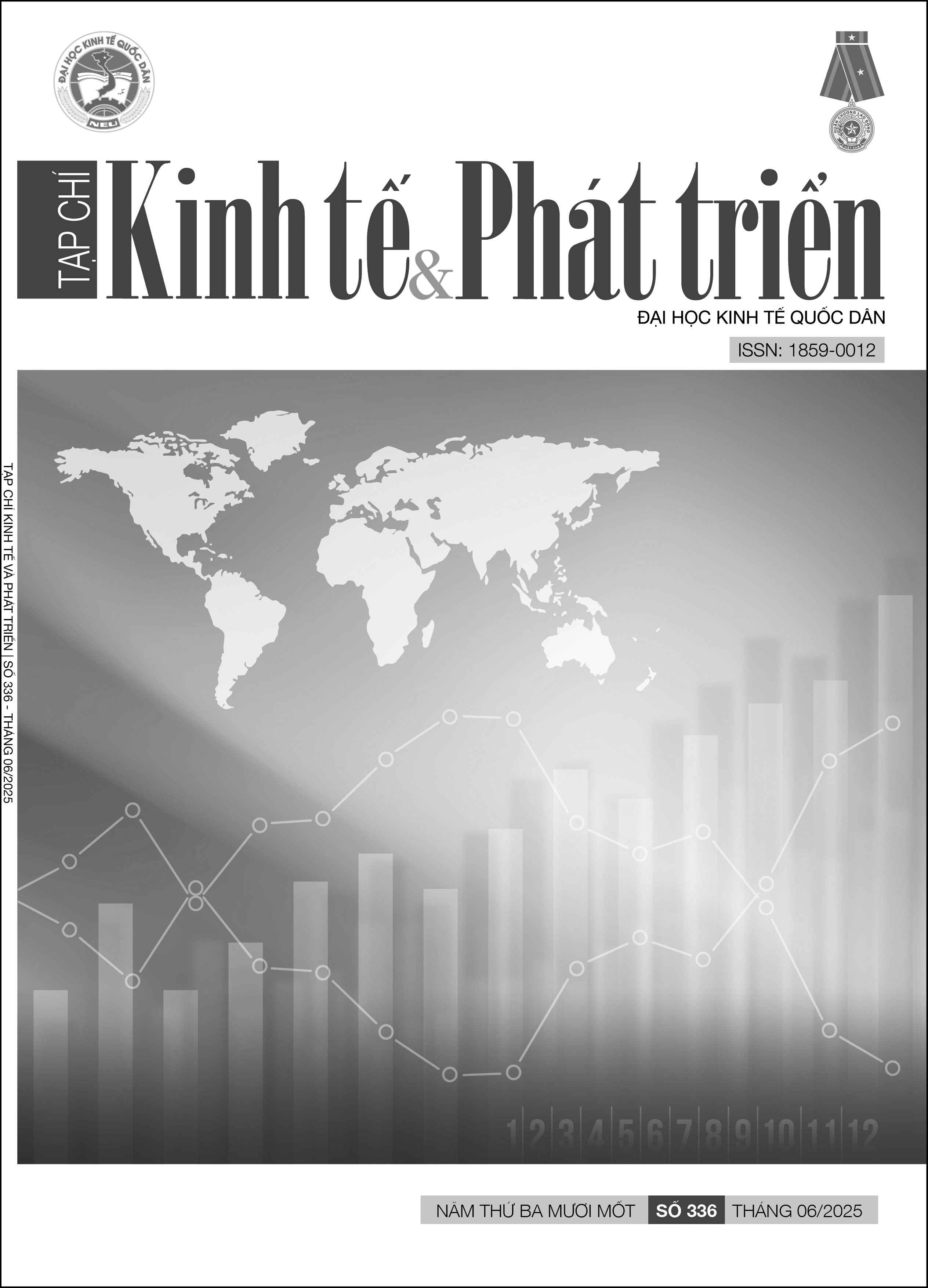Tác động không đồng nhất của đa dạng hóa kinh tế đến chất lượng môi trường ở Việt Nam
DOI:
https://doi.org/10.33301/JED.VI.2071Từ khóa:
Đa dạng hóa cơ cấu, Đa dạng hóa tài chính, Đa dạng hóa cơ hội, Chất lượng môi trường, Việt NamTóm tắt
Các quốc gia đang phát triển như Việt Nam luôn phải đối mặt với mục tiêu kép là thúc đẩy tăng trưởng kinh tế gắn liền với bảo vệ môi trường. Nghiên cứu này được thực hiện để kiểm định tác động của ba dạng đa dạng hóa kinh tế gồm: đa dạng hóa cơ cấu, đa dạng hóa tài chính, và đa dạng hóa cơ hội đến chất lượng môi trường ở Việt Nam giai đoạn 1986 đến 2022. Bằng việc áp dụng phương pháp ước lượng bình phương nhỏ nhất, và công cụ phân tích Wavelet, bài viết đã chỉ ra những tác động không đồng nhất của đa dạng hóa kinh tế đến nguy cơ suy thoái chất lượng môi trường ở các miền thời gian và miền tần số khác nhau. Dựa trên kết quả thực nghiệm, bài viết khuyến nghị các cơ quan quản lý Nhà nước và doanh nghiệp cần nghiên cứu sâu sắc hơn từng dạng đa dạng hóa kinh tế để đạt được mục tiêu phát triển bền vững cho Việt Nam.
Tài liệu tham khảo
Aziz, G., Sarwar, S., Waheed, R., & Khan, M. S. (2024). The significance of renewable energy, globalization, and agriculture on sustainable economic growth and green environment: Metaphorically, a two-sided blade. Natural Resources Forum, 48(3), 763-783.
Bijay, S., & Craswell, E. (2021). Fertilizers and nitrate pollution of surface and ground water: an increasingly pervasive global problem. SN Applied Sciences, 3, 518.
Bloomfield, D. S., McAteer, R. T. J., Lites, B. W., Judge, P. G., Mathioudakis, M., & Keenan, F. P. (2004). Wavelet Phase Coherence Analysis: Application to a Quiet‐Sun Magnetic Element. The Astrophysical Journal, 617(1), 623-632.
Bùi Hoàng Ngọc & Bùi Vũ Quỳnh Anh. (2024). Nghiên cứu sự đánh đổi giữa hạnh phúc của người dân và dấu chân sinh thái ở Việt Nam. Tạp chí Khoa học Đại học Mở Thành phố Hồ Chí Minh – Kinh tế và Quản trị Kinh doanh, 19(9), 65-78.
Cao, Y. K., Cai, J. X. N., & Liu, X. Y. (2024). Advancing toward a sustainable future: assessing the impact of energy transition, circular economy, and international trade on carbon footprint. Economic Change and Restructuring, 57(2), 26.
Deng, Q. S., Alvarado, R., Cuesta, L., Tillaguango, B., Murshed, M., Rehman, A., & López-Sánchez, M. (2022). Asymmetric impacts of foreign direct investment inflows, financial development, and social globalization on environmental pollution. Economic Analysis and Policy, 76, 236-251.
Godil, D. I., Sharif, A., Rafique, S., & Jermsittiparsert, K. (2020). The asymmetric effect of tourism, financial development, and globalization on ecological footprint in Turkey. Environmental Science and Pollution Research, 27(32), 40109-40120.
Goupillaud, P., Grossmann, A., & Morlet, J. (1984). Cycle-octave and related transforms in seismic signal analysis. Geoexploration, 23(1), 85-102.
Grossman, G. M. (1995). Pollution and growth: What do we know? In I. Goldin & L. A. Winters (Eds.), The economics of sustainable development (pp. 19–46). Cambridge University Press. https://doi.org/10.1017/CBO9780511751905.003.
Hung, N. T. (2022). Time–frequency nexus between globalization, financial development, natural resources and carbon emissions in Vietnam. Economic Change and Restructuring, 55, 2293-2315.
Lieu, P. T., & Ngoc, B. H. (2023). The relationship between economic diversification and carbon emissions in developing countries. International Journal of Applied Economics, Finance and Accounting, 15(1), 21-28.
Lindmark, M. (2002). An EKC-pattern in historical perspective: carbon dioxide emissions, technology, fuel prices and growth in Sweden 1870–1997. Ecological Economics, 42(1), 333-347.
Lv, Z., & Li, S. (2021). How financial development affects CO2 emissions: A spatial econometric analysis. Journal of Environmental Management, 277, 111397.
Nelson, C. R., & Plosser, C. I. (1982). Trends and random walks in macroeconmic time series. Journal of Monetary Economics, 10(2), 139-162.
Ngoc, B. H., & Tram, N. H. M. (2024). Spillover impacts of financial development and globalization on environmental quality in ASEAN countries. Heliyon, 10(9), e30149.
Pata, U. K. (2021). Renewable and non-renewable energy consumption, economic complexity, CO2 emissions, and ecological footprint in the USA: testing the EKC hypothesis with a structural break. Environmental Science and Pollution Research, 28(1), 846-861.
Sohag, K., Vasilyeva, R., Voytenkov, V., & Hammoudeh, S. (2024). Natural resource extraction and economic diversification in Russian regions: Application of dynamic DID. Energy Economics, 136, 107759.
Torrence, C., & Webster, P. J. (1999). Interdecadal Changes in the ENSO–Monsoon System. Journal of Climate, 12(8), 2679-2690.
Tram, N. H. M., & Ngoc, B. H. (2024). Environmental Foe or Friend: The Impact of Intellectual Capital and Ambidextrous Innovation on Environmental Performance. SAGE Open, 14(2), 1-17.
Van de Walle, N. (2023). Economic Diversification in Nigeria: The Politics of Building a Post-Oil Economy. Foreign Affairs, 102(1), 209-209.
Vũ Hữu Thành, Nguyễn Minh Hà, & Nguyễn Minh Kiều. (2018). Đa dạng hóa kinh doanh, hiệu quả và rủi ro. Tạp chí Khoa học Đại học Mở Thành phố Hồ Chí Minh – Kinh tế và Quản trị Kinh doanh, 13(1), 20-37.
Zhang, H. W., Khan, K. A., Eweade, B. S., & Adebayo, T. S. (2024). Role of eco-innovation and financial globalization on ecological quality in China: A wavelet analysis. Energy & Environment, 10.1177/0958305x241228518.





